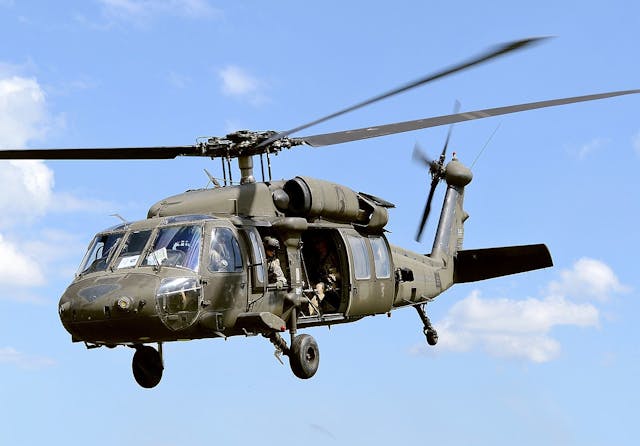Checking Out the Thrills and Innovations of the Blackhawk Helicopter
The Blackhawk helicopter stands as a testament to armed forces air travel's development, merging technological innovations with useful applications. What exists ahead for this iconic airplane, and exactly how will emerging innovations shape its future in armed forces procedures?
History of the Blackhawk Helicopter
Given that its beginning in the 1960s, the Blackhawk helicopter has actually played a critical function in modern army aviation. Developed by Sikorsky Aircraft, the UH-60 Blackhawk was created to fulfill the united state Military's demand for a flexible energy helicopter with the ability of doing a selection of goals, including troop transport, medical discharge, and cargo airlift. The design was a reaction to the restrictions of earlier helicopters, especially in regards to survivability, rate, and maneuverability.
The Blackhawk made its initial trip in 1974 and soon got in solution in 1979. Its intro noted a considerable innovation in helicopter modern technology, including a two-rotor system that boosted efficiency and security. The airplane's tough building and advanced avionics allowed it to run successfully in diverse environments and conditions.
Throughout the years, the Blackhawk has been continuously updated, integrating lessons gained from various fight scenarios. Its implementation in disputes such as the Gulf Battle, Somalia, and the Battle on Fear additional solidified its online reputation as an indispensable property. The Blackhawk's tradition is identified by its adaptability and durability, making it a cornerstone of army aviation for years.
Key Features and Specs
The Blackhawk helicopter is distinguished by its durable style and progressed technological features, which collectively boost its operational abilities. Made mostly for energy missions, the Blackhawk flaunts a maximum launch weight of around 22,000 pounds, permitting it to bring significant hauls while maintaining dexterity.
Outfitted with two General Electric T700-GE-701C engines, the Blackhawk achieves a maximum rate of around 183 knots and a range of 368 nautical miles - Blackhawk Helicopter. Its modern blades system features a four-blade major rotor and a four-blade tail blades, ensuring stability and ability to move in various flying problems
The helicopter's cabin can suit approximately 11 troops or different cargo arrangements, showcasing flexibility in mission accounts. In addition, the Blackhawk is developed with advanced avionics, including digital flight controls and a comprehensive cockpit screen, boosting pilot situational awareness.
For enhanced survivability, the Blackhawk integrates ballistic shield and self-sealing gas tanks. Its capacity to operate in diverse environments, from deserts to icy terrains, even more strengthens its credibility as a reputable system for humanitarian and army procedures alike. The Blackhawk's combination of power, convenience, and strength makes it a foundation of modern-day airborne capabilities.
Developments in Innovation
Technologies in modern technology have actually considerably enhanced the capabilities of the Blackhawk helicopter, ensuring it remains at the leading edge of army aeronautics. One of one of the most notable improvements is the assimilation of sophisticated avionics systems, which offer improved situational understanding with real-time data handling and display. This technology permits pilots to browse complicated atmospheres better, improving mission success prices.

Moreover, the intro of digital fly-by-wire systems has actually revolutionized the control mechanisms of the Blackhawk, providing smoother handling and boosted responsiveness. Jointly, these technical improvements make certain that the Blackhawk helicopter continues to be a vital possession in modern-day military operations.
Functions in Military Workflow
With innovative innovation enhancing its abilities, the Blackhawk helicopter plays a multifaceted function in army procedures. Largely, it is employed for troop transportation, making it possible for rapid release useful link and extraction of personnel in numerous battle situations. Its large cabin can suit approximately 11 soldiers, making it a crucial asset for massive objectives and unique procedures.
Additionally, the Blackhawk serves as a medevac system, outfitted to move damaged soldiers promptly and successfully from the field of battle to medical facilities - Blackhawk Helicopter. Its adaptability encompasses logistical support, where it carries materials and devices important for maintaining military procedures in remote locations

The helicopter is likewise instrumental in reconnaissance missions, providing airborne surveillance and intelligence-gathering capabilities. Its capacity to run in diverse settings-- ranging from urban setups to severe surfaces-- additional solidifies its relevance on the combat zone.
Additionally, the Blackhawk can be furnished with innovative weapons, allowing it to involve in combat and provide close air support. This flexibility highlights the helicopter's important role in modern-day military techniques, making it an essential element of militaries worldwide.
Future Advancements and Innovations
Advancements in innovation pledge to usher in a brand-new era for the Blackhawk helicopter, improving its capacities and functional performance. Future developments for the Blackhawk might consist check my reference of enhancements in avionics, such as advanced flight control systems and enhanced situational awareness devices powered by artificial intelligence.
In addition, the integration of unmanned systems is on the horizon, potentially permitting manned-unmanned teaming procedures that can increase mission profiles and lower danger to workers. The Blackhawk's style is likewise expected to integrate lighter and more powerful products, boosting gas performance and total performance.

Conclusion
Finally, the Blackhawk helicopter stands for a considerable achievement in armed forces air travel, identified by its flexibility and advanced technical attributes. Its historic evolution mirrors a consistent action to operational requirements, enhancing capacities in numerous roles such as troop transport and medevac operations. Ongoing developments, including the integration of expert system and hybrid-electric propulsion, promise to additional enhance the Blackhawk's performance and importance in future military engagements, guaranteeing its condition as a vital possession on the battlefield.

With sophisticated innovation improving its capacities, the Blackhawk helicopter plays a multifaceted role in military procedures. (Blackhawk Helicopter)